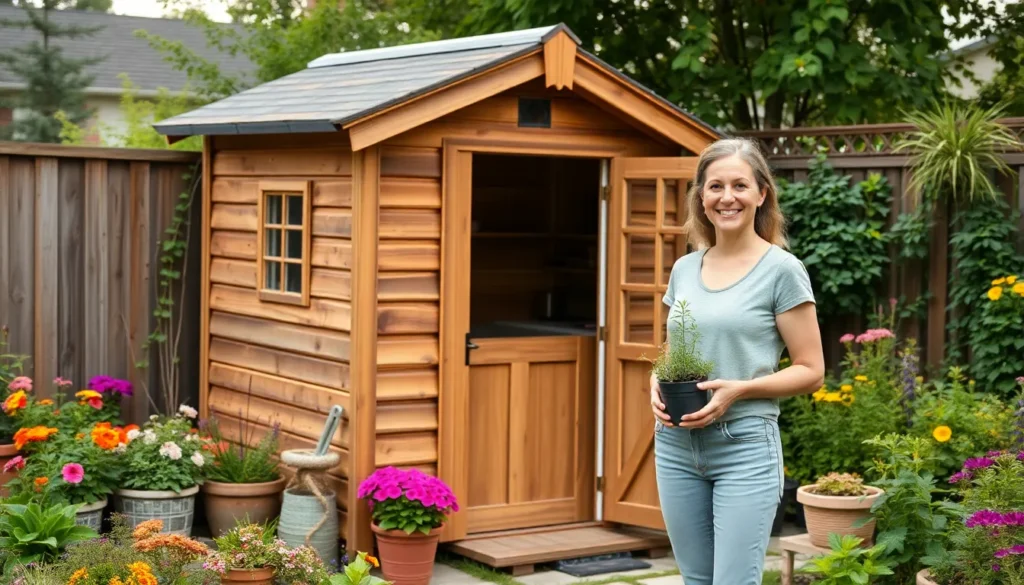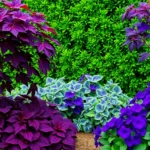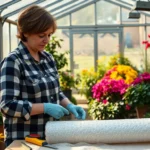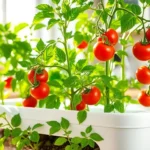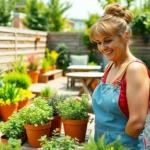We’ve all dreamed of transforming our outdoor spaces into something truly special. Whether you’re working with a sprawling backyard or a cozy corner garden, the right structures can turn any area into your personal oasis. From charming pergolas that create intimate dining spaces to practical storage sheds that keep your tools organized, garden buildings add both function and beauty to your industry.
The best part? You don’t need to be a master carpenter or have an unlimited budget to create stunning garden features. Today’s DIY-friendly designs and affordable materials make it easier than ever to build structures that’ll enhance your property value while giving you years of enjoyment.
We’ll explore creative ideas that work for every skill level and budget. You’ll discover how simple additions like trellises, gazebos, and custom planters can completely transform your outdoor living experience and create the garden retreat you’ve always wanted.
Charming Garden Shed Ideas for Storage and Style
Garden sheds serve as both practical storage answers and stunning focal points that enhance your outdoor sanctuary. We’ve compiled inspiring options that blend functionality with aesthetic appeal to transform your garden space.
Traditional Wooden Sheds with Character
Classic barn style sheds bring timeless charm to any garden with their peaked roofs and rustic appeal. We recommend cedar or pine construction for natural weather resistance and beautiful aging patters. Board and batten siding creates authentic farmhouse character while providing excellent protection for tools and equipment.
Cottage style wooden sheds feature charming details like window boxes, decorative trim, and painted finishes in soft pastels or crisp whites. Add climbing roses or ivy around the entrance to create a storybook appearance. These structures work beautifully as potting sheds with interior shelving and work surfaces.
Log cabin inspired sheds offer substantial storage with distinctive horizontal log construction. Chinking between logs provides insulation while maintaining the rustic aesthetic. We suggest adding a small porch with rocking chairs to create a garden retreat space alongside your storage needs.
Modern Metal Sheds for Durability
Sleek steel sheds provide maximum durability with minimal maintenance requirements in contemporary garden settings. Powder coated finishes resist rust and fading while offering color options like charcoal, forest green, or classic white. These structures withstand harsh weather conditions and require no seasonal treatments.
Aluminum frame sheds combine lightweight construction with corrosion resistance for long lasting storage answers. Double wall panels provide insulation while maintaining clean lines that complement modern industry designs. We particularly appreciate the wide door openings that accommodate riding mowers and large equipment.
Galvanized metal sheds offer exceptional value with zinc coating that prevents rust for decades. Corrugated panels create interesting texture while providing structural strength. Color matched trim pieces allow customization to match your home’s exterior or garden color scheme.
Converted Vintage Structures
Repurposed chicken coops transform into charming storage spaces with their distinctive peaked roofs and ventilation features. Remove interior roosting bars to create open storage areas while preserving character elements like nesting boxes for tool organization. Paint in bright colors to create cheerful garden focal points.
Old barn sections salvaged from demolished structures bring authentic rural character to modern gardens. Weathered wood siding tells stories while providing functional storage space. We recommend reinforcing foundations and adding modern roofing while preserving original hardware and architectural details.
Converted greenhouse frames offer unique storage answers with their glass or polycarbonate panels creating bright interior spaces. Remove growing benches to accommodate larger items while maintaining the distinctive peaked or curved roof designs. These structures work particularly well for storing garden furniture during winter months.
Creative Greenhouse Designs for Year-Round Growing
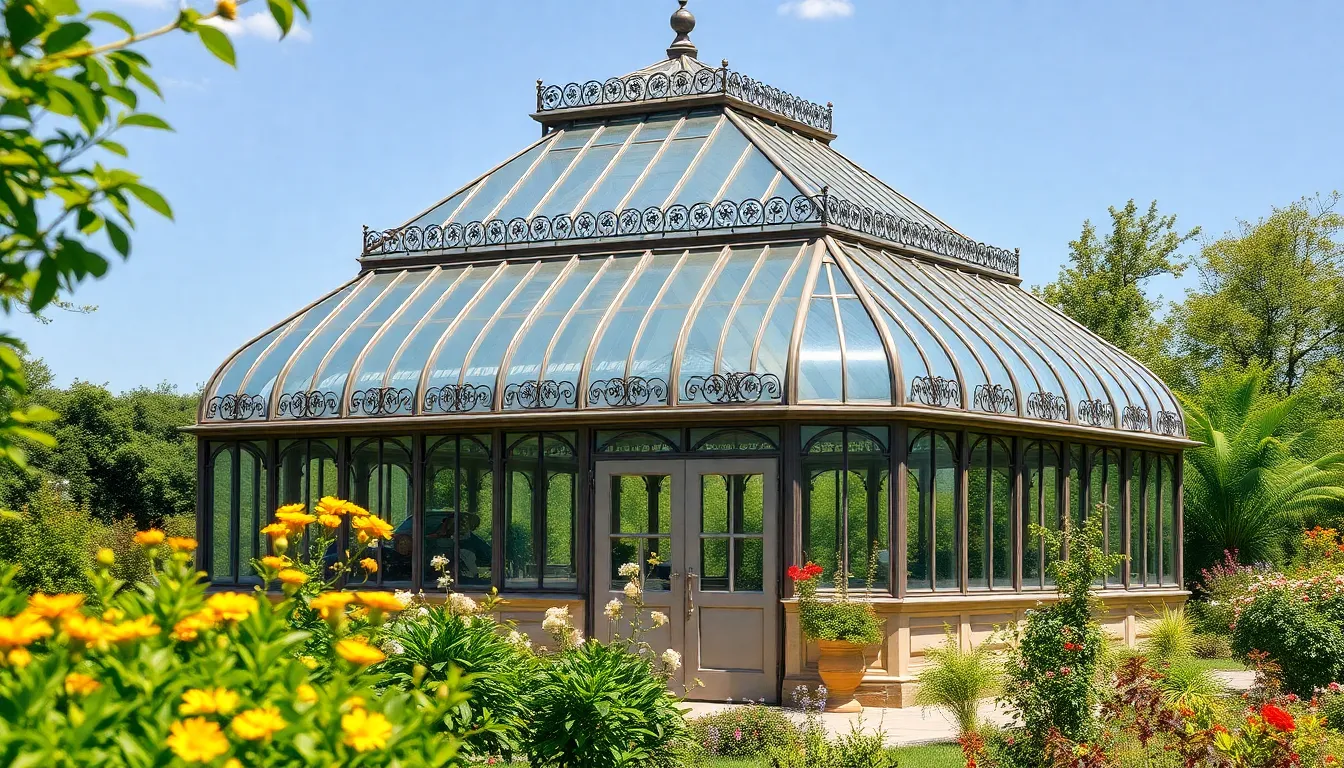
Greenhouses transform our growing seasons and enable us to cultivate fresh produce throughout the year. We’ve compiled innovative designs that maximize efficiency while fitting various budgets and skill levels.
DIY Hoop House Constructions
Building your own hoop house requires just PVC pipes or metal framing covered with heavy duty plastic film or polycarbonate panels. We recommend this cost effective approach because it’s incredibly easy to construct and perfect for beginners.
Materials recycling reduces expenses even further when we incorporate old windows or doors into our designs. These repurposed elements add character while maintaining functionality for year round growing.
Construction involves bending pipes into arcs and securing them to ground anchors or wooden base frames. We cover the structure with durable greenhouse plastic that withstands weather extremes and provides excellent light transmission.
Glass Victorian-Style Greenhouses
Victorian style greenhouses bring elegant charm to our garden spaces with their ornate metalwork and traditional glass panels. These classic designs evoke the timeless beauty of English country gardens while providing sophisticated growing environments.
Modern heating systems integrate seamlessly with traditional Victorian aesthetics to ensure year round growing capabilities. We can maintain optimal temperatures throughout winter months while preserving the authentic architectural appeal.
Decorative elements like curved eaves, ridge cresting, and elaborate door frames distinguish these greenhouses from standard models. The combination of form and function creates stunning focal points that enhance our overall garden design.
Lean-To Greenhouse Attachments
Lean to greenhouses attach directly to existing structures like our homes or garden sheds to create seamless transitions between indoor and outdoor spaces. We benefit from shared walls that provide structural support and reduce construction costs significantly.
Design functionality shines when we position these attachments to capture maximum sunlight while protecting plants from harsh weather conditions. The shared wall also helps maintain consistent temperatures through thermal mass transfer.
Plant selection works exceptionally well for high climbing vegetables and fruits like tomatoes and cucumbers that can use the vertical growing space. We maximize our harvest potential while creating attractive green walls that enhance our property’s curb appeal.
Functional Potting Shed Plans for Garden Organization
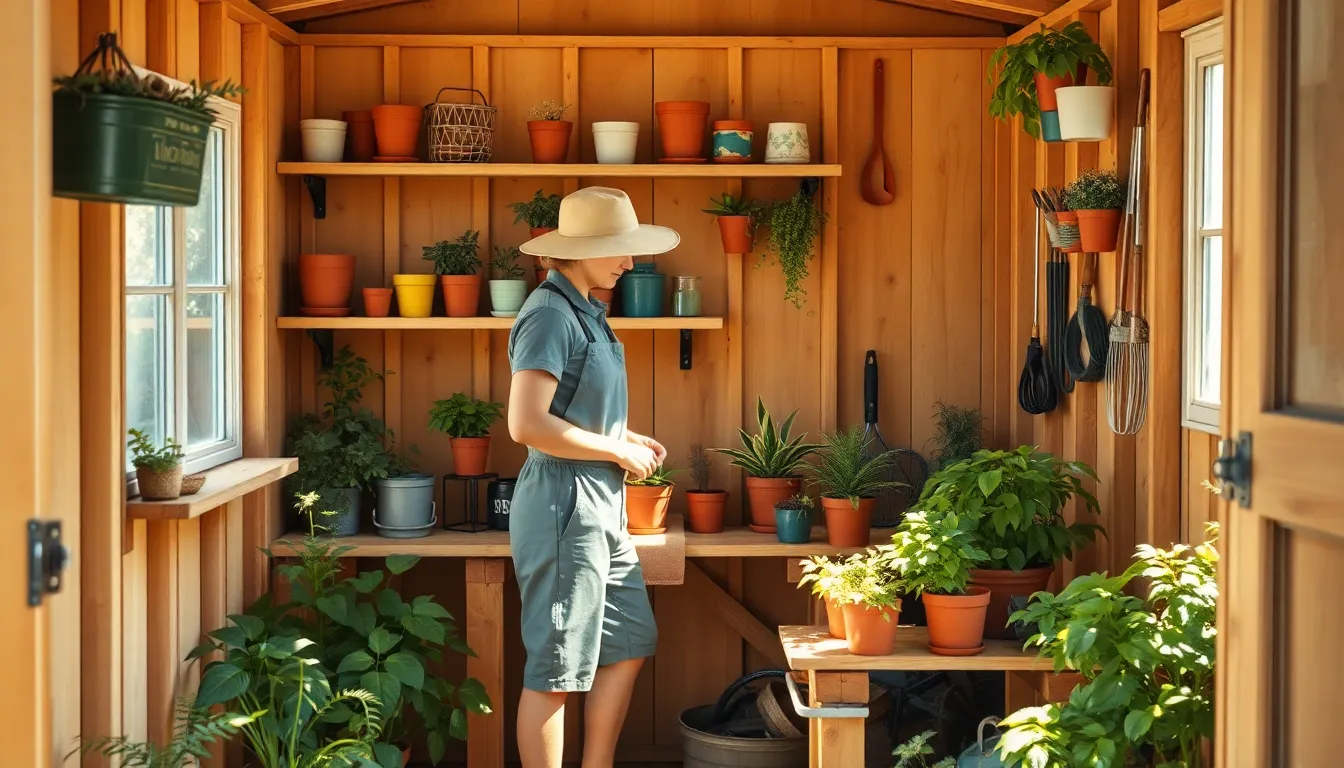
We’ve designed these garden building answers to maximize both workspace efficiency and storage capacity in compact areas. Our focus centers on three key elements that transform any potting area into an organized gardening hub.
Compact Corner Potting Benches
L-shaped corner potting benches provide the perfect solution for maximizing workspace in smaller garden areas. We recommend constructing these benches with elevated sides that prevent soil spills and keep your floor clean during messy repotting tasks. The corner design naturally creates two distinct work zones, allowing you to separate clean and dirty gardening activities while maintaining easy access to both areas.
Corner installations make efficient use of space that’s often underutilized in traditional shed layouts. Built-in storage underneath these benches accommodates large bags of soil, fertilizer containers, and bulk gardening supplies. The wraparound design allows two people to work simultaneously without crowding, making it ideal for family gardening projects or when you need to tackle multiple tasks at once.
Multi-Level Storage Answers
Vertical storage systems dramatically increase your organization capacity without expanding your garden building’s footprint. We use open shelves mounted at different heights to accommodate various pot sizes, from small seedling containers to large decorative planters. The multi-level approach keeps frequently used items at eye level while storing seasonal supplies on higher shelves.
| Storage Level | Recommended Items | Height Range |
|---|---|---|
| Floor Level | Large bags, wheelbarrows | 0-2 feet |
| Work Surface | Daily tools, small pots | 2-3 feet |
| Eye Level | Seeds, labels, gloves | 3-6 feet |
| Upper Storage | Seasonal items, ladders | 6-8 feet |
Overhead storage racks handle less frequently used equipment like extension ladders and holiday decorations. These elevated systems keep valuable floor space clear while ensuring everything remains accessible when needed. We position heavier items on lower levels and lighter seasonal materials above, creating a balanced and safe storage environment.
Integrated Tool Organization Systems
Pegboard walls transform empty vertical space into highly functional tool storage areas. We install these systems along entire walls, using various hook sizes to accommodate everything from hand trowels to long-handled rakes. The visual organization system makes it easy to spot missing tools and maintain inventory of your gardening equipment.
Shaker-style peg rails offer an elegant alternative to traditional pegboards while providing excellent hanging storage for larger tools. These rails support substantial weight and create attractive display areas for well-maintained garden implements. We mount these systems at varying heights to accommodate different tool lengths and user preferences.
Specialized tool racks designed for exact equipment types keep everything organized and prevent damage from improper storage. Rake and shovel holders maintain proper spacing between long-handled tools, while smaller compartmentalized systems organize hand tools by category. These integrated systems eliminate the frustration of searching through cluttered tool piles and extend the life of your gardening equipment.
Relaxing Garden Pavilion Structures for Outdoor Living
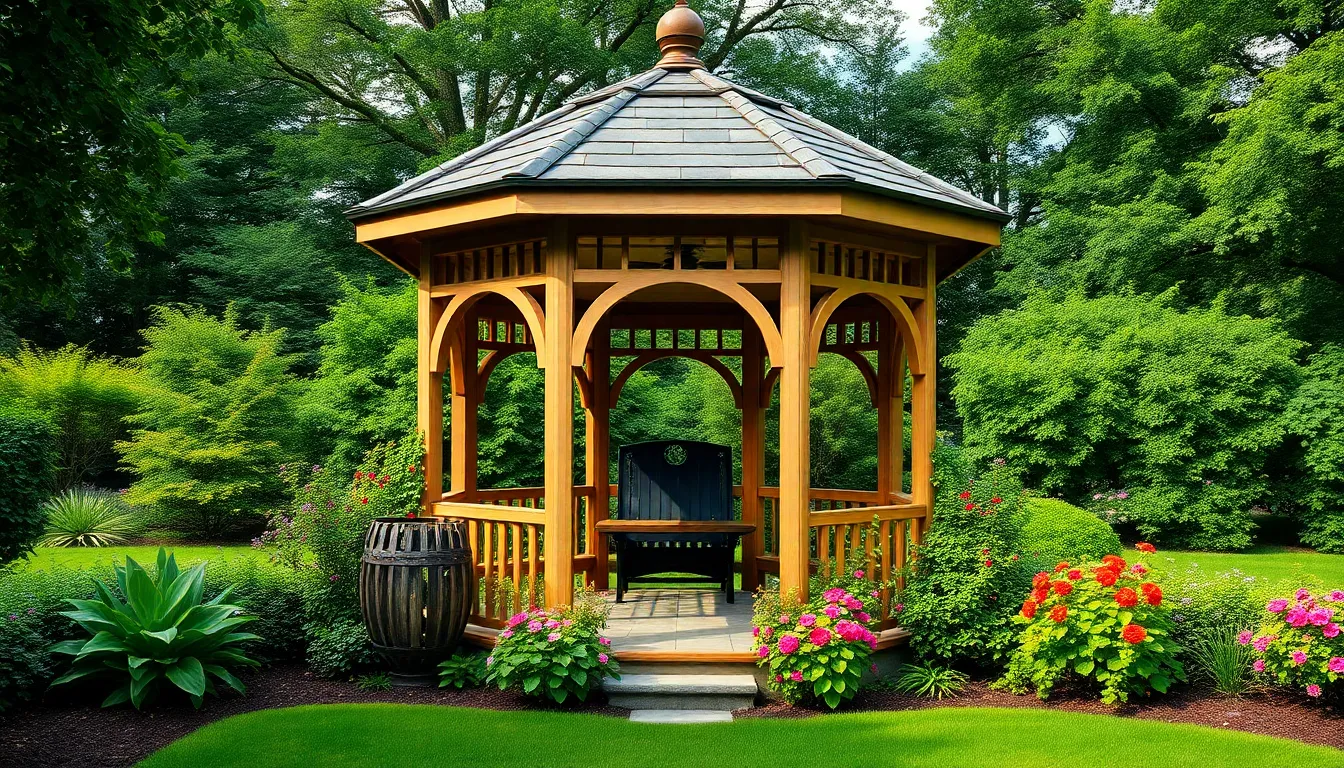
Garden pavilions transform outdoor spaces into elegant entertainment areas that bridge the gap between indoor comfort and natural beauty. We’ve found that these structures create perfect gathering spots for family meals and social events while adding architectural interest to any industry.
Open-Air Gazebo Designs
Gazebos serve as stunning focal points that anchor garden designs while providing sheltered spaces for relaxation and entertaining. Classic octagonal shapes offer balanced aesthetics with ample room for seating arrangements or outdoor dining sets. We recommend Amish-built gazebos for their exceptional craftsmanship and intricate details that ensure both beauty and long-lasting durability.
Materials like cedar and redwood provide natural resistance to decay, making them ideal choices for structures that face constant weather exposure. Shingled roofing systems deliver superior weather protection while maintaining traditional appeal. Adding lattice panels creates opportunities for climbing plants like clematis or jasmine to provide natural shade and romantic ambiance.
Pergola-Style Covered Areas
Pergolas create partially shaded outdoor rooms that work perfectly for dining areas or casual lounging spaces. These versatile structures support climbing vines and flowering plants that add lush, natural elements to your outdoor living areas. We’ve seen how pergolas can define exact zones within larger gardens while maintaining an open, airy feeling.
Construction typically involves sturdy posts and crossbeams that create geometric patterns overhead. Grape vines, wisteria, or climbing roses transform plain pergolas into living canopies that provide cooling shade during summer months. Strategic placement near patios or decks extends your indoor living space seamlessly into the garden.
Screened-In Garden Rooms
Screened garden rooms extend your outdoor living season by providing bug-free, weather-protected spaces for relaxation and entertainment. These enclosed structures allow you to enjoy nature’s beauty without dealing with insects or unexpected weather changes. We’ve discovered that proper screening materials and ventilation systems create comfortable environments for dining, reading, or hosting gatherings.
Built-in seating, ambient lighting, and ceiling fans enhance comfort levels while maintaining the outdoor atmosphere. Weather-resistant furniture and storage answers help these spaces function as true outdoor living rooms. Strategic window placement maximizes natural light while providing views of surrounding gardens and landscapes.
Productive Chicken Coop Ideas for Backyard Poultry
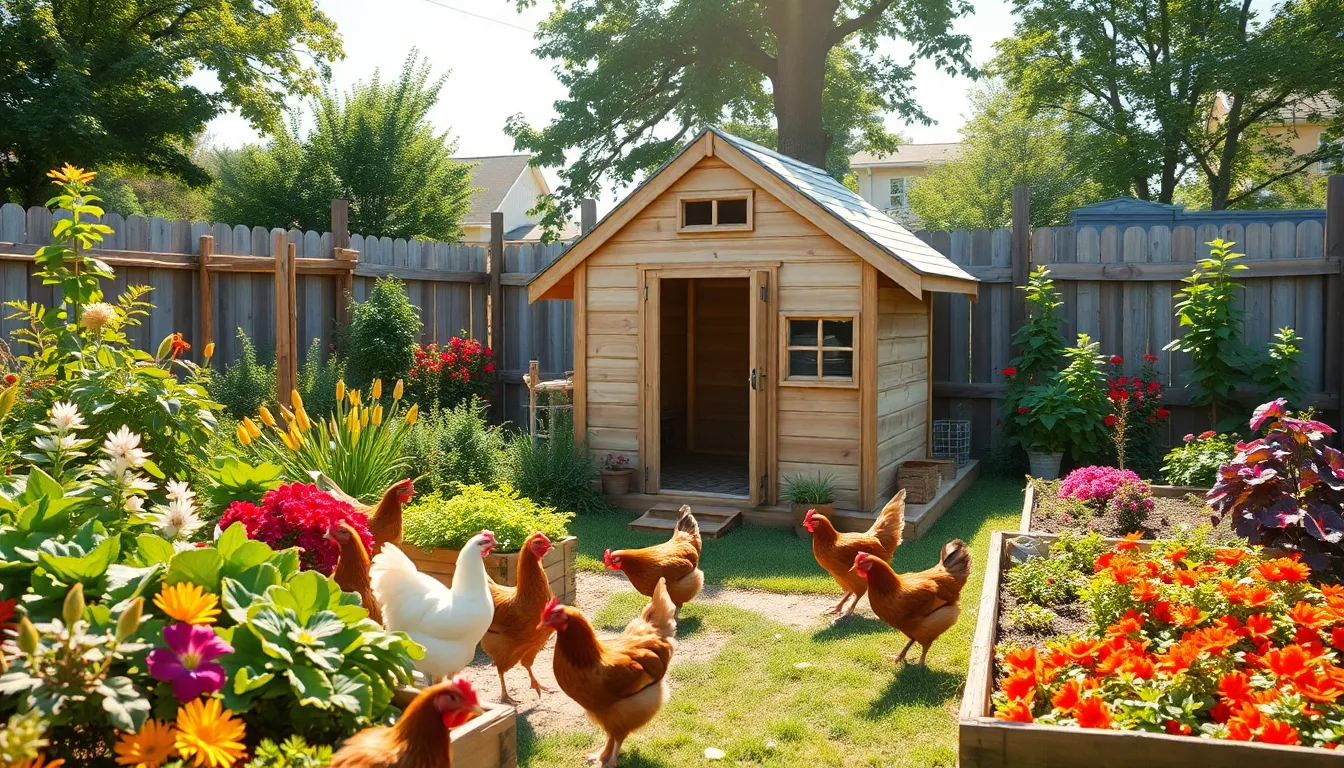
Building productive chicken coops transforms our backyard spaces into efficient poultry systems that benefit both our birds and our gardens. We’ll explore innovative designs that maximize space utilization while promoting chicken health and garden productivity.
Portable Tractor Style Coops
Portable chicken tractors provide fresh ground daily for our flocks while naturally improving soil health through their mobility. These moveable structures reduce parasite buildup by preventing chickens from staying in one location too long.
A-frame designs offer exceptional stability and customizable sizing options for different flock numbers. We can easily move these structures manually, and they accommodate 3-6 large hens or up to 10 bantams in dimensions around 4’x4’x8′. The Green Willow Homestead A-frame plan features a robust tow bar attachment that allows effortless relocation across dirt roads and trails.
Flat bottom tractors create more interior space for chickens while maintaining portability benefits. Construction typically uses recycled wood and chicken wire, making these designs both affordable and environmentally friendly for small yard applications.
Cattle panel models combine durability with cost effectiveness, utilizing curved metal panels that create spacious interiors. We can customize these structures with removable nesting boxes and wheel systems for easy repositioning throughout our property.
Elevated Coop Designs
Elevated coops raise our chickens’ living spaces above ground level, protecting them from predators, dampness, and harmful pests. This design approach allows waste to fall naturally below the structure, reducing our cleanup requirements while providing valuable compost material for garden beds.
Stilted structures create dry, well ventilated environments that prevent moisture related health issues in our flocks. We can use the space underneath for storage or additional garden beds, maximizing our backyard’s productive potential.
Platform designs incorporate open air ventilation systems that maintain optimal air circulation without creating drafts. These structures often feature removable components for easy cleaning and seasonal modifications.
Multi level systems combine roosting areas on upper levels with ground access through ramps or ladders. We benefit from increased capacity within smaller footprints while providing natural behavioral opportunities for our chickens.
Integrated Garden and Coop Systems
Integrated systems maximize space efficiency while creating beneficial relationships between our chickens and garden plants. These designs combine poultry housing with growing areas to optimize nutrient cycling and natural pest control.
Movable coop arrangements allow us to rotate chickens through different garden sections systematically. Our birds forage for insects and weeds while their manure enriches soil naturally, creating sustainable growing conditions.
Permanent structures with adjacent runs provide consistent housing while maintaining garden integration benefits. We can design fenced areas that connect directly to planting beds, allowing controlled access for soil preparation and pest management.
Bucket nesting systems offer cost effective answers for both egg layers and meat birds within garden integrated designs. These removable components help easy cleaning while maintaining the flexibility to relocate nesting areas as needed.
Combined layouts feature strategic positioning that allows chickens to access compost areas, fallen fruit, and garden waste while protecting growing crops. We create natural fertilizer systems that reduce external inputs while maintaining productive growing spaces.
Stylish Garden Office Spaces for Remote Work

Remote work has transformed our backyard sheds and unused garden corners into productive office spaces that blend professional functionality with natural tranquility. We’re seeing homeowners create dedicated workspaces that provide privacy while maintaining that essential connection to nature through strategic design choices.
Insulated Year-Round Offices
Energy efficient insulation makes garden offices comfortable during every season, allowing us to work productively regardless of weather conditions. Thermal insulation materials maintain consistent temperatures while reducing energy consumption by up to 40% compared to non-insulated structures.
Solar panels integrated into office roofs provide renewable energy that can power our workspace equipment, lighting, and climate control systems. We can reduce grid dependency by 60-80% when combining solar installations with proper insulation techniques.
Collaborative workspaces within insulated offices accommodate multiple desks for co-working setups, making them ideal for shared projects or client meetings. Floor-to-ceiling windows maximize natural light while maintaining thermal efficiency through double-glazed installations.
Hybrid office and gym combinations use foldable desks and discreet equipment storage to create multipurpose spaces that serve both professional and fitness needs.
Eco-Friendly Green Roof Designs
Sustainable materials like reclaimed wood, recycled metal, and bamboo construction create environmentally conscious garden offices that blend seamlessly with natural surroundings. Green roofs enhance insulation properties while providing natural temperature regulation throughout the year.
Rainwater harvesting systems integrated into green roof designs reduce water consumption by collecting precipitation for garden irrigation and office use. We can capture 600-1,000 gallons annually from a standard 200-square-foot office roof.
Biophilic design principles incorporate large glass doors and indoor greenery to maximize our connection with nature during work hours. Living walls and integrated planters improve air quality while creating calming visual elements that reduce workplace stress.
Native plant selections for green roofs require minimal maintenance while supporting local wildlife ecosystems and pollinator habitats.
Converted Shed Office Spaces
Renovation projects transform existing sheds into functional workspaces through strategic updates including insulation installation, window additions, and proper door placement. We can complete most shed conversions for 30-50% less than new construction costs.
Modular furniture systems maximize limited square footage while ensuring workspace flexibility for changing professional needs. Vertical storage answers and wall-mounted desks create efficient layouts without overwhelming compact spaces.
Electrical upgrades provide adequate power for computers, printers, and lighting while meeting local building codes for office use. Proper ventilation systems ensure air quality and comfort during extended work sessions.
| Conversion Element | Average Cost | Timeline |
|---|---|---|
| Insulation & Drywall | $1,200-2,000 | 3-5 days |
| Electrical Installation | $800-1,500 | 2-3 days |
| Windows & Doors | $600-1,200 | 1-2 days |
| Flooring | $400-900 | 1-2 days |
Exterior updates including fresh paint, landscaping, and pathway creation enhance curb appeal while creating a professional appearance for video calls and client visits.
Entertaining Garden Bar and Kitchen Concepts

Creating outdoor entertainment spaces elevates garden building ideas beyond simple storage answers. These multifunctional areas combine cooking, dining, and socializing into one cohesive outdoor experience.
Outdoor Pizza Oven Structures
Building a brick or stone pizza oven transforms your backyard into an authentic culinary destination. We recommend positioning these ovens as centerpieces surrounded by spacious patios that accommodate dining tables and comfortable seating arrangements.
Covered areas enhance pizza oven functionality throughout different weather conditions. Pergolas or gazebos provide essential protection from rain and intense sunlight while maintaining the open air dining experience. Materials like cedar or composite wood create lasting structures that complement the rustic appeal of stone ovens.
Fresh herb gardens positioned near pizza ovens supply immediate access to basil, oregano, rosemary, and other Mediterranean flavors. These compact growing spaces reduce trips to indoor kitchens while adding aromatic elements to outdoor cooking areas.
Tiki Bar Themed Designs
Authentic tiki decor creates tropical garden escapes using thatched roofs, bamboo accents, and vibrant colored lanterns. We’ve found that incorporating tropical plants like palms and hibiscus establishes lush atmospheres that transport guests to island destinations.
Rattan bars with matching stools provide comfortable seating while maintaining the tropical aesthetic. Retro style wooden signs add personality and help define different areas within larger entertainment spaces. These decorative elements work together to create cohesive themed environments.
Lighting plays a crucial role in tiki bar ambiance during evening gatherings. Tiki torches provide flickering flames that create dramatic shadows and warm glows. String lights add secondary illumination while maintaining the relaxed tropical vibe that makes these spaces so appealing.
Built-In Grilling Stations
Grill stations with integrated countertops maximize food preparation efficiency by providing dedicated workspace adjacent to cooking surfaces. We recommend incorporating sinks and storage compartments for utensils, seasonings, and grilling accessories within arm’s reach of the main cooking area.
Seating areas positioned near grill stations encourage social interaction between cooks and guests. Outdoor furniture arrangements should allow clear sightlines to cooking activities while maintaining comfortable conversation distances. Bar height seating works particularly well for casual dining and appetizer service.
Outdoor refrigerators installed near grilling stations eliminate frequent trips to indoor kitchens for beverages and ingredients. These appliances maintain proper food temperatures while providing convenient access to cold drinks, marinades, and perishable items throughout extended cooking sessions.
Child-Friendly Playhouse Garden Buildings

Building playhouse garden structures creates magical outdoor spaces where children can explore their imagination while parents enjoy peace of mind. These specialized structures transform ordinary backyards into adventure-filled environments that encourage creative play and outdoor activity.
Fairy Tale Castle Designs
Fantasy themed playhouses transport children into storybook adventures through carefully crafted architectural details. We recommend incorporating towers and turrets into your castle design to create that authentic medieval fortress appearance. Adding a functional drawbridge provides an interactive element that kids absolutely love operating.
Customization options for castle playhouses are virtually limitless, allowing you to tailor the structure to your child’s favorite fairy tales. Flags and banners can be mounted on tower peaks to flutter in the breeze. Creating a shallow decorative moat around the perimeter adds another layer of fantasy while serving as a natural boundary for the play area.
| Castle Feature | Purpose | Child Appeal Rating |
|---|---|---|
| Towers and Turrets | Architectural authenticity | High |
| Drawbridge | Interactive play element | Very High |
| Flags and Banners | Visual enhancement | Medium |
| Decorative Moat | Boundary and fantasy | High |
Treehouse Style Elevated Structures
Elevated playhouses offer unique play experiences by lifting children above ground level for adventure and exploration. These structures can be built around existing trees or supported by posts when suitable trees aren’t available. We suggest using sturdy lumber for the platform foundation to ensure long term stability and safety.
Safety features are essential components of any elevated structure design. Railings should be installed around all open edges to prevent falls. Secure ladders or stairs provide safe access routes for children of different ages and abilities. We recommend using non slip materials on steps and platform surfaces to reduce accident risks.
Integration with existing industry elements makes treehouse structures feel natural and established. Wrapping the design around tree branches creates an authentic treehouse experience. Building elevated sections at varying heights adds visual interest and creates different play zones within the same structure.
Multi Activity Play Complexes
Integrated play areas combine multiple entertainment options into cohesive outdoor recreation centers. These complexes typically feature a central playhouse or clubhouse surrounded by various activity stations. We recommend including swings, slides, and climbing walls to provide diverse physical challenges for growing children.
Versatility in design allows these complexes to adapt to different backyard sizes and family needs. Modular components can be arranged in configurations that maximize available space. Corner installations work well for smaller yards while sprawling designs suit larger properties.
Activity zones should be planned to complement each other and create natural play flow patterns. Placing quiet areas like reading nooks away from high energy zones reduces conflicts. We suggest incorporating storage answers within the complex to keep outdoor toys and equipment organized and protected from weather.
| Complex Component | Physical Benefit | Recommended Age Range |
|---|---|---|
| Climbing Walls | Upper body strength | 5-12 years |
| Swings | Balance and coordination | 3-10 years |
| Slides | Spatial awareness | 2-8 years |
| Central Playhouse | Imaginative play | 3-12 years |
Practical Workshop Buildings for Garden Projects
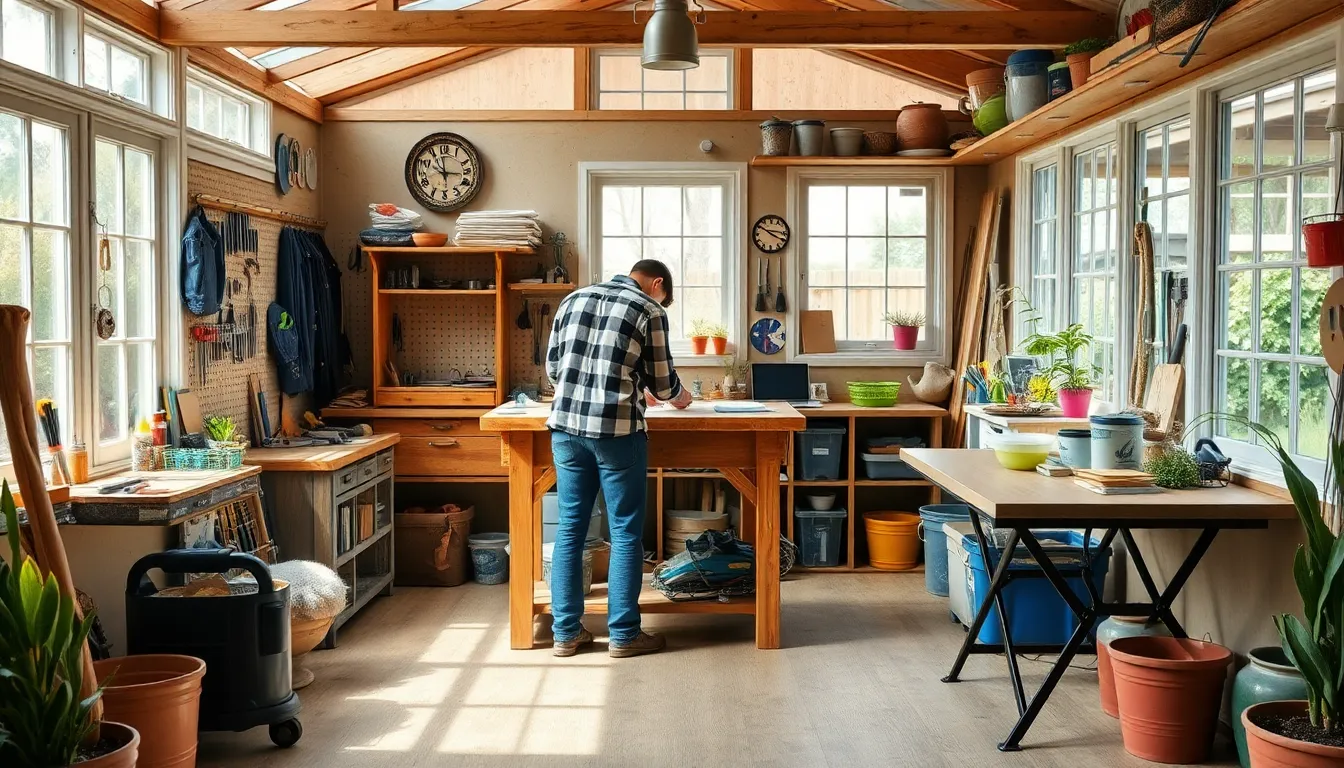
Dedicated workshop spaces transform ordinary garden areas into productive zones where creativity and functionality merge seamlessly. We’ve found that properly designed garden workshops serve multiple purposes while maintaining the aesthetic appeal of outdoor spaces.
Woodworking Shop Layouts
Workbench placement becomes critical for maximizing workflow efficiency in compact garden workshops. Position your primary work surface in the center of the space to allow movement around all sides during project assembly. This central arrangement creates natural work triangles between your bench, tool storage, and material staging areas.
Tool organization systems using pegboards and specialized toolboxes keep essential equipment within arm’s reach. Mount pegboards on walls adjacent to your workbench to display frequently used hand tools like chisels, squares, and measuring devices. Rolling toolboxes work exceptionally well in garden workshops since they can move with you as projects shift locations.
Storage answers incorporating vertical shelving and built-in cabinets accommodate lumber and bulk supplies efficiently. Install adjustable shelving systems along one wall to handle different board lengths and widths. Cedar lumber storage racks work particularly well in garden settings due to their natural moisture resistance.
General Purpose Create Spaces
Flexibility in design allows these workshops to accommodate multiple activities from painting to pottery throughout the year. Create modular work surfaces using folding tables that can be reconfigured based on your current project needs. This adaptability proves invaluable when transitioning between seasonal crafts or hosting group activities.
Lighting requirements demand both natural and artificial sources to support detailed work during any time of day. Large windows positioned on the north-facing wall provide consistent, even illumination without harsh shadows. Supplement this with adjustable task lighting and overhead fixtures to maintain proper visibility during evening hours.
Comfort elements including proper seating and planning areas enhance the overall workshop experience. Install a small table or counter height surface specifically for project planning, sketching, and taking breaks. Ergonomic seating options like adjustable stools work well since they can be stored under work surfaces when not needed.
Tool Storage and Workbench Combinations
Integrated storage answers within workbench designs maximize efficiency while minimizing floor space requirements. Workbenches with built-in drawers and cabinet compartments keep hand tools organized and protected from garden moisture. These combinations work particularly well in 8×12 or 10×16 shed configurations where every square foot matters.
Mobile toolbox systems provide flexibility for accessing frequently used equipment across different work zones. Rolling tool carts allow you to bring essential tools directly to your project rather than walking back and forth to fixed storage locations. This mobility becomes especially valuable when working on larger pieces that can’t be moved easily.
Wall-mounted tool holders and magnetic strips use vertical space while keeping cutting tools safely organized. Magnetic tool strips work excellently for metal tools like wrenches and screwdrivers, while custom wooden holders accommodate handled tools like hammers and mallets. These systems keep sharp tools visible and safely stored above work surfaces.
Eco-Friendly Sustainable Garden Building Options

Building garden structures with environmental consciousness creates beautiful outdoor spaces while protecting our planet for future generations.
Recycled Material Constructions
Reclaimed lumber transforms old materials into stunning garden buildings that showcase unique character and history. Salvaged barn wood creates rustic sheds with weathered textures that blend naturally into garden landscapes. Old window frames become charming greenhouse walls that filter sunlight beautifully while reducing construction costs significantly.
Repurposed metal materials offer durability and industrial appeal for modern garden structures. Shipping containers convert into spacious workshops or storage areas with minimal modification required. Salvaged metal roofing provides weather protection while adding distinctive architectural elements to garden buildings.
Creative upcycling projects turn everyday discarded items into functional garden features. Old doors become decorative shed entrances with vintage hardware and glass panels intact. Discarded pallets transform into vertical planters, garden walls, or small storage structures with simple assembly techniques.
Solar-Powered Building Features
Solar panel installations on garden building roofs generate clean electricity for lighting and power tools. Modern solar systems provide sufficient energy to run LED lighting, small fans, and charging stations for cordless garden equipment. Installation costs continue decreasing while efficiency improvements make solar power increasingly attractive for garden structures.
Solar powered irrigation systems eliminate dependency on grid electricity for watering gardens. Automated drip irrigation networks operate entirely on solar energy, delivering precise water amounts to plants throughout the day. These systems include programmable timers and moisture sensors that optimize water usage based on actual plant needs.
Solar lighting creates ambient atmosphere in garden buildings without increasing electricity bills. String lights powered by small solar panels illuminate workshop areas, potting sheds, and entertainment spaces after sunset. Motion activated solar security lights provide safety around garden buildings while deterring unwanted visitors.
Rainwater Collection Integration
Rain barrel systems collect precious water resources directly from garden building roofs for irrigation purposes. Simple barrel installations beneath downspouts capture hundreds of gallons during typical rainfall events. Connected barrel systems multiply collection capacity while gravity fed distribution eliminates pumping requirements.
Underground cistern installations store larger volumes of rainwater for extended dry periods. These advanced systems collect water from multiple roof areas and filter it through sediment screens before storage. Buried cisterns maintain cooler water temperatures and prevent algae growth that occurs in above ground containers.
Grey water recycling systems redirect water from garden building sinks for plant irrigation. Simple filtration systems remove soap residues while preserving beneficial nutrients that plants can use. These systems reduce fresh water consumption by 30-50% in typical garden applications while supporting healthy plant growth.
Conclusion
We’ve explored countless ways to transform your backyard into something truly special. From practical storage answers to entertainment spaces these garden building ideas prove that you don’t need expensive contractors or extensive experience to create your dream outdoor retreat.
The key is starting with structures that match your lifestyle and skill level. Whether you’re drawn to sustainable eco-friendly designs or prefer classic wooden buildings there’s a perfect project waiting for you.
Remember that the best garden buildings serve multiple purposes while improving your property’s overall appeal. They should reflect your personal style and grow with your changing needs over time.
Your outdoor space has unlimited potential. With careful planning and the right approach you can create a backyard that becomes your favorite place to relax work and connect with nature.
Frequently Asked Questions
What garden structures can I build without advanced carpentry skills?
You can easily build pergolas, trellises, gazebos, hoop house greenhouses, and simple storage sheds using DIY-friendly designs. Many projects use basic materials like PVC pipes, reclaimed lumber, and prefab components that require minimal cutting or complex joinery, making them perfect for beginners.
How much does it cost to build a garden shed?
Garden sheds can range from $200-500 for simple DIY builds using recycled materials to $2,000-5,000 for larger, custom structures. Cost-effective options include repurposing old materials, choosing metal sheds for durability, or building basic wooden structures with standard lumber and hardware store supplies.
What’s the difference between a greenhouse and a hoop house?
A hoop house is a simple, curved structure made from PVC or metal hoops covered with plastic sheeting, costing $100-300. Greenhouses are more permanent structures with glass or polycarbonate panels, better insulation, and ventilation systems, typically costing $500-3,000 or more depending on size and features.
Can I convert an existing shed into a garden office?
Yes, existing sheds make excellent garden offices with proper insulation, electrical work, and ventilation. Add windows for natural light, install heating/cooling systems, and create ergonomic workspaces. Ensure proper weatherproofing and consider solar panels for sustainable energy. Professional electrical installation may be required for safety.
What materials work best for outdoor garden structures?
Cedar and redwood offer natural decay resistance for wooden structures. Metal options like galvanized steel provide durability with low maintenance. Recycled materials like reclaimed lumber add character while reducing costs. Consider local climate conditions when choosing materials, and always use weather-resistant hardware and finishes.
How do I maximize storage in a small potting shed?
Use vertical space with multi-level shelving, overhead storage racks, and wall-mounted pegboards for tools. Install L-shaped corner benches to create distinct work zones. Add hooks, magnetic strips, and specialized tool racks. Consider fold-down work surfaces and rolling carts to maximize functionality in compact spaces.
Are chicken coops difficult to build and maintain?
Modern chicken coop designs are beginner-friendly with simple construction requirements. Portable chicken tractors are easiest to build and maintain. Focus on proper ventilation, predator protection, and easy cleaning access. Elevated designs reduce maintenance while integrated garden systems create beneficial relationships between chickens and plants.
What permits do I need for garden buildings?
Permit requirements vary by location and structure size. Generally, structures under 100-120 square feet may not require permits, but check local building codes. Permanent structures with electrical, plumbing, or foundations typically need permits. Contact your local building department before starting any significant garden building project.
How can I make my garden structures eco-friendly?
Use recycled and reclaimed materials like salvaged lumber and repurposed metal. Install solar panels for lighting and power. Implement rainwater collection systems and greywater recycling. Choose locally-sourced materials to reduce transportation impact. Consider green roofs with native plants for insulation and wildlife habitat support.
What’s the best location for a garden greenhouse?
Choose a south-facing location with 6-8 hours of direct sunlight and protection from strong winds. Ensure easy access to water and electricity. Consider proximity to your home for convenience during winter months. Avoid low-lying areas where cold air settles, and provide adequate drainage around the foundation.

